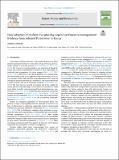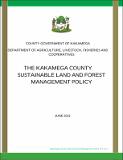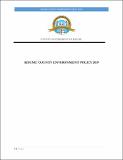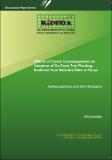Does adoption of on-farm tree planting depend on Forest co-management? Evidence from selected Forest sites in Kenya
| dc.contributor.author | Laichena, Joshua | |
| dc.date.accessioned | 2022-10-12T13:17:08Z | |
| dc.date.available | 2022-10-12T13:17:08Z | |
| dc.date.issued | 2021 | |
| dc.identifier.uri | https://repository.kippra.or.ke/handle/123456789/3870 | |
| dc.description.abstract | Kenya’s forest sector operated without a formal forest policy until 1957 when White Paper No. 85 of 1957 was published, and which outlined ten principles on forest management: Reservation; protection; management; industry; finance; employment; African areas; private forests and other forests not under the State ownership; public amenity, and; wildlife research and education. The first principle was restated as a policy in 1968 through Sessional Paper No. 1 of 1968 and adopted as the Forest Act (Cap. 385). This Act provided for development of the Kenya Forestry Master Plan and establishment control and regulation of central forests and forest areas in Nairobi and on unalienated government land under the Forests Department. Under this governance regime, access to State forests was tightly controlled by forest guards who ensured continued forest health through exclusion, and only activities approved by the Forest Department were carried out. Forest neighbouring communities and other stakeholders remained mere spectators in forest management. Nonetheless, in the 1970s and 1980s, Kenya was rated highly in plantation development alongside countries such as Chile | en |
| dc.language.iso | en | en |
| dc.publisher | ScienceDirect.com | en |
| dc.relation.ispartofseries | Journal Article;2021 | |
| dc.subject | Forest Co-management | en |
| dc.subject | Forest Management | en |
| dc.subject | Ecosystem | en |
| dc.subject | Natural Resources | en |
| dc.subject | Agroforestry Practices | en |
| dc.title | Does adoption of on-farm tree planting depend on Forest co-management? Evidence from selected Forest sites in Kenya | en |
| dc.type | Article | en |
Files in this item
This item appears in the following Collection(s)
-
Journal Articles [31]




